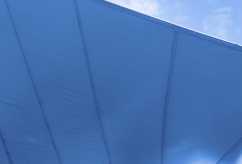What is % UVR Block ?

Percentage UVR block relates to the performance of the shadecloth that reflect or absorb incident Ultra Violet Radiation (UVR) within the 290nm to 400nm range of the spectrum. This includes UV-A radiation (315nm to 400nm) and UV-B radiation (280nm to 315 nm). For example, Aquatic Blue shadecloth has a 94.2% UVR block which means that in laboratory test conditions ~94% of incident Ultra Violet Radiation (290nm to 400nm) is absorbed or reflected by the shadecloth.
Research worldwide has shown that mainly UV-B, and to a lesser extent UV-A, radiation is harmful to humans and often causes sunburn. Additionally, chronic exposure to UVR has shown a relationship to increased rates of skin cancer. Therefore, the percentage of UVR block is an important factor when selecting shadecloth designed to protect people.
The higher the percentage UVR block, the better the shadecloth protects against Ultra Violet Radiation within the 290nm to 400nm range of the spectrum.
We list % UVR Block on our technical data because The Australian Standard AS 4174 – 1994 Synthetic Shadecloth calls for the Percentage UVR Block of shadecloth to be measured. This varies with different colours and with different qualities of shadecloth.
This allows users to choose the most appropriate level of UVR protection for their application and compare different types of shadecloth under standardised test conditions.
Remember this data only covers incident UVR and does not include reflected and diffused UVR which will vary from installation to installation.
UVR Block varies between different brands and types shadecloth. This heavily depends on the construction and more importantly the quality of the UV stabiliser in the material of the shadecloth. Because the shadecloth actually absorbs some of the UVR, a shadecloth with less UV stabiliser may break-down, or fail in sunlight faster than other fabrics.
This is one reason why GALE Pacific offers a 10 year warranty against UV failure on certain shadecloth.


